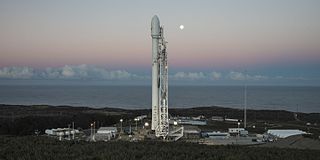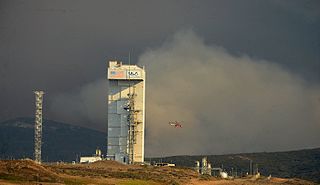
Vandenberg Space Force Base is a United States Space Force Base located 14.8 km (9.2 mi) northwest of Lompoc, California. Established in 1941, Vandenberg Space Force Base is a space launch base, launching spacecraft from the Western Range and also performs missile testing. The United States Space Force's Space Launch Delta 30 serves as the host delta for the base. In addition to its military space launch mission, Vandenberg Space Force Base also performs space launches for civil and commercial space entities, such as NASA.

The Western Range (WR) is the space launch range that supports the major launch head at Vandenberg Space Force Base. Managed by the Space Launch Delta 30, the WR extends from the West Coast of the United States to 90 degrees East longitude in the Indian Ocean where it meets the Eastern Range Operations involve military, government, and commercial interests. The WR has been operated by civilian contractors since its establishment, following the precedent of the Eastern Range. On 2003-10-01, InDyne Inc. took over the range contract from ITT Industries which had operated the range for the previous 44 years.

Space Launch Complex 6 at Vandenberg Space Force Base in California is a launch pad and support area. The site was originally developed for Titan III rockets and the Manned Orbiting Laboratory, but these were cancelled before construction of SLC-6 was complete. The complex was later rebuilt to serve as the west coast launch site for the Space Shuttle, but went unused due to budget, safety and political considerations. The pad was subsequently used for several Athena rocket launches before being modified to support the Delta IV launch vehicle family, which have used the pad since 2006.

The 21st Space Operations Squadron is a satellite control unit of the Space Delta 6 of the United States Space Force, located at Vandenberg Air Force Base, California. Prior to July 2020, it was part of the 50th Network Operations Group. It operated Onizuka Air Force Station from its formation in 1991 until the closure of the station in 2010.

Space Launch Delta 30 is a United States Space Force space launch delta assigned to Space Operations Command and headquartered at Vandenberg Space Force Base, California. The Space Launch Delta 30 is responsible for all space launch operations from the west coast, which includes all polar launches. It manages the Western Range and launch activities for the Space Force, Department of Defense, NASA, and other private space corporations. The Space Launch Delta 30 also supports test and evaluation launches of the U.S. Air Force's intercontinental ballistic missile force.

Space Launch Complex 10, or Missile Launch Complex 10, is located on Vandenberg Space Force Base in Lompoc, California. It was built in 1958 to test ballistic missiles and developed into a space launching facility in 1963. Prior to 1966 Space Launch Complex 10 West was known as Vandenberg AFB Pad 75-2-6. It remains a rare pristine look at the electronics and facilities created in that era that helped the United States grow its space capabilities.

The 2nd Space Launch Squadron is an active United States Space Force unit. It is located at Vandenberg Air Force Base, California, and was reactivated in July 2019 with the merger of the 4th Space Launch Squadron and the 1st Air and Space Test Squadron.

The United States Air Force's 4th Space Launch Squadron was a space launch unit located at Vandenberg Air Force Base, California. It was active at Vandenberg from 1994 to 1998 and again from 2003 to 2019. It launched various satellites into orbit from the complex of launch pads at Vandenberg.

Space Launch Complex 4 (SLC-4) is a launch and landing site at Vandenberg Space Force Base, California, U.S. It has two pads, both of which are used by SpaceX for Falcon 9 launch operations, and operates as Landing Zone 4 (LZ-4) for SpaceX landings.

Space Launch Complex 5 (SLC-5) was a launch pad at Vandenberg Space Force Base in California, United States. It was previously part of the Point Arguello Naval Air Station, during which time it was designated Launch Complex D or LC-D. Constructed in 1961, it was used by 69 Scout launch vehicles between 1962 and 1994. Satellites launched from the complex included Transit, OV3, Explorer and P35 (DMSP) spacecraft. Most of the satellites launched from SLC-5 were placed into low Earth orbits, or low medium Earth orbits.

Space Launch Complex 8 (SLC-8), is a launch pad at Vandenberg Space Force Base in California, United States. It is used by Minotaur rockets. It was originally part of the California Spaceport, and was known as the Commercial Launch Facility (CLF) or Space Launch Facility (SLF).

The United States Space Force's 18th Space Control Squadron is a space control unit located at Vandenberg AFB, California. Reactivated in 2016, the 18th SPCS is tasked with providing 24/7 support to the space surveillance network (SSN), maintaining the space catalog and managing United States Space Command’s space situational awareness (SSA) sharing program to United States, foreign government, and commercial entities. The squadron also conducts advanced analysis, sensor optimization, conjunction assessment, human spaceflight support, reentry/break-up assessment, and launch analysis.

The 10th Aerospace Defense Group was inactivated on 31 December 1970 by the United States Air Force (USAF). Its last assignment was with Fourteenth Aerospace Force at Vandenberg Air Force Base, California. The 10th Aerospace Defense Group and Squadron were the sole operators of the United States' second nuclear-tipped anti-satellite weapon, Weapons System 437 (WS-437). For this reason the squadron continues the group history through temporary bestowal.
Vandenberg Space Force Base Launch Facility 04 (LC-04) is a former United States Air Force (USAF) Intercontinental ballistic missile (ICBM) launch facility on Vandenberg Space Force Base, California, USA. It is a launch site for the land-based LGM-30 Minuteman missile series.

Space Launch Complex 1 (SLC-1) was a launch pad at Vandenberg Space Force Base in California, United States. SLC-1 consisted of two pads, SLC-1E and SLC-1W. Both sites were built in 1958 for the never activated 75th Strategic Missile Squadron for Thor Agena A launches. SLC-1E launch pad 75-3-5, SLC-1W launch pad 75-3-4. Both were upgraded to a Space Launch Complex (SLC) in 1966. Deactivated with phaseout of Thor-Agena. SLC-1E deactivated 1968, 45 launches; SLC-1W deactivated in 1971, 56 launches.

The Canyon Fire was a wildfire that burned on Vandenberg Air Force Base in Santa Barbara County, California during September 2016. By the time the fire was contained on September 24, it had burned 12,742 acres (51.6 km2) of land. Due to the nature of the activities that take place on the Base, there were a number of unique challenges posed during the fire including the presence of potentially hazardous materials.

Space Operations Command (SpOC) is a field command of the United States Space Force. Headquartered at Peterson Air Force Base, Colorado, it is responsible for the organization, training, equipping, command and control, and employment of space forces to support operational plans and missions for U.S. combatant commanders. It is also responsible for the Space Force's launch wings, 30th Space Wing and 45th Space Wing until the activation of Space Systems Command.

Space Delta 5 is a delta of the United States Space Force, responsible for preparing, presenting, and fighting assigned and attached forces for the purpose of conducting operational-level command and control (C2) of space forces to achieve theater and global objectives. It provides the majority of the forces and the structure for the Combined Space Operations Center. Activated on 24 July 2020, the delta is headquartered at Vandenberg Air Force Base, California. Its current commander is Colonel Monique C. DeLauter.

The structure of the United States Space Force consists of four main bodies: the Office of the Secretary of the Air Force, the Space Staff, the field commands, and the space deltas.


















